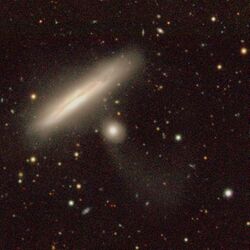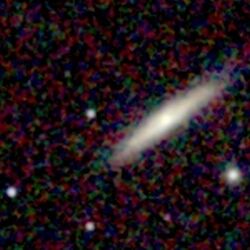Astronomy:NGC 52
From HandWiki
Short description: Edge-on Spiral galaxy in the constellation of Pegasus
| NGC 52 | |
|---|---|
 NGC 52 and nearby PGC 1563523 (lower right) as seen on legacy survey | |
| Observation data (2000.0 epoch) | |
| Constellation | Pegasus |
| Right ascension | 00h 14m 40.2s [1] |
| Declination | +18° 34′ 48″ [1] |
| Redshift | 0.017986 |
| Helio radial velocity | 5390 km/s |
| Distance | 243,000,000ly[2] (73,000,000 Parsecs)[3] |
| Apparent magnitude (V) | 14.6 [4] |
| Characteristics | |
| Type | Sc [2] |
| Size | 150,000[2] |
| Apparent size (V) | 2.6' × 0.5' [1] |
| Other designations | |
| UGC 140, CGCG 456-042, CGCG 12.0+1817, MCG+03-01-030, 2MFGC 00177, 2MASX J00144010+1834551, 2MASXi J0014401+183455, IRAS 00120+1818, IRAS F00120+1818, AKARI J0014401+183453, LDCE 0011 NED002, PGC 978, UZC J001440.2+183454, NVSS J001440+183455 [5] | |
NGC 52 (PGC 978) is an edge-on spiral galaxy in the constellation Pegasus. It was discovered on September 18, 1784, by William Herschel. He described it as "very faint, small, extended."[2]
Physical characteristics
The galaxy is approximately 150,000 light years across.[2] This makes it, in comparison, about 1.5 times as large as the Milky Way. The galaxy also has a satellite elliptical galaxy called PGC (Principal Galaxies Catalogue) 1563523.
See also
References
- ↑ 1.0 1.1 1.2 "NGC 52 - DeepSkyPedia :: Astronomy". http://www.deepskypedia.com/wiki/NGC_52.
- ↑ 2.0 2.1 2.2 2.3 2.4 "New General Catalog Objects: NGC 50 - 99". http://cseligman.com/text/atlas/ngc0a.htm.
- ↑ "parsecs to lightyears conversion". http://www.unitconversion.org/length/parsecs-to-light-years-conversion.html.
- ↑ "Category:NGC 52 - Wikimedia Commons". http://commons.wikimedia.org/wiki/Category:NGC_52.
- ↑ "Your NED Search results". http://ned.ipac.caltech.edu/cgi-bin/objsearch?objname=NGC+52&extend=no&hconst=73&omegam=0.27&omegav=0.73&corr_z=1&out_csys=Equatorial&out_equinox=J2000.0&obj_sort=RA+or+Longitude&of=pre_text&zv_breaker=30000.0&list_limit=5&img_stamp=YES.
External links
- NGC 52 on WikiSky: DSS2, SDSS, GALEX, IRAS, Hydrogen α, X-Ray, Astrophoto, Sky Map, Articles and images
- SEDS
Coordinates: ![]() 00h 14m 40.2s, +18° 34′ 48″
00h 14m 40.2s, +18° 34′ 48″
 |


